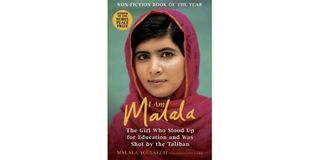How Malala defied Taliban, stood up for girls’ education

The cover page of Malala Yousafzai's memoir.
What you need to know:
- The Pakistani Taliban banned girls from attending school in Swat Valley after their northern Pakistani occupation.
- Malala's advocacy thrust her tenacity into the limelight as she grew into Pakistan's most vocal and buoyant girl.
- In 2014, at the age of 17, she became the world's youngest Nobel Peace Prize Laureate.
On Tuesday, October 9, 2012, in Mingora City, Swat Valley, northern Pakistan, 15-year-old Malala Yousafzai boarded a Toyota van to Khushal School, a hundred miles from Pakistan’s capital, Islamabad. She sat at the windowless back of the van with her best friend, Moniba.
A young bearded man in light-coloured clothes stepped onto the road and flagged down the van. He entered and enquired if that was the Khushal School van.
The driver, Usman Bhai Jan, answered in the affirmative, buoyed by his assumption that the man was one of the journalists covering Malala's resistance to the Taliban's opposition to girls’ education.
"Who is Malala?" the stranger asked. All the other girls turned their eyes towards Malala.
The man unleashed an automatic pistol. As the rest of the girls screamed, Malala squeezed Moniba's hand in horror. The attacker fired three loud ear-shattering shots. The first hit Malala's head. She slumped forward onto Moniba, blood profusely oozing from her left ear.
The other two bullets hit the girls near her amid a pungent smell of gunpowder. One bullet went into one girl's left hand, and another tore through her left shoulder and proceeded into the upper arm of another girl.
When Malala arrived at the hospital, her hair and Moniba’s lap were drenched in blood. It was the first time the Taliban had directly attacked a girl in Pakistan. It had been incomprehensible in Pakistan and neighbouring Afghanistan, for a schoolgirl to speak against Taliban oppression.
After Malala's shooting, the militant jihadist Pashtun group, the Taliban, claimed responsibility for the attack.
Memoir
Malala is famous for her girls' education advocacy in Swat Valley. In her memoir, I am Malala: The Girl Who Stood Up for Education and Was Shot by the Taliban, she takes the reader through a historical journey, a gripping tale of Buddhist, Shia and Sunni Islamic Pakistan.
She includes the country's bloody cessation on August 14, 1947, and the Arabisation of Swat Valley by religious deviants.
The Pakistani Taliban banned girls from attending school in Swat Valley after their northern Pakistani occupation. Malala's advocacy thrust her tenacity into the limelight as she grew into Pakistan's most vocal and buoyant girl. In 2014, at the age of 17, she became the world's youngest Nobel Peace Prize Laureate.
After the occupation of Swat by the Taliban, women and girls were subjected to purdah, a curtained seclusion formality from public observation. CD and DVD shops were banned, and moral police were created. They dressed in black and carried AK-47 rifles while searching for offenders.
A woman accompanied by a man would be waylaid and required to prove her relation to the man. The Taliban combatively ensured all women wore burqas (enveloping outer garments that cover the body and the face).
A woman who was raped was expected to present four male witnesses as proof of the crime. The Taliban began holding a local court called Shura. Punishment included public whippings, which had never been sighted before in Mingora.
The Taliban attacked cinemas and tore down billboards with pictures of women. They snatched female mannequins from clothing shops and harassed men wearing western-style shirts and trousers instead of the traditional shalwar kamiz.
Health workers were banned from providing polio drops.
The Taliban insisted the vaccinations were an American plot to inject infertility in Muslim women and exterminate the Swat population. Women were prevented from decorating themselves with henna (removable ink tattoos) during Ramadan celebrations.
They were mandated to cover their heads to remove all traces of womankind from public life. Malala protested by not covering her head with the traditional hijab, the custom headgear for Islamic women.
The Taliban began blowing up schools during a night-time curfew that they imposed, insisting the institutions were haram (forbidden).
When she was 11, Malala accorded her first television interview to ATV Khyber, fuelled by girls dropping out of school because of militancy.
ATV Khyber was the only privately owned Pashto television channel.
Since most girls feared talking to the media, Malala's eloquence and conviction was covered by news channels. She took up the media opportunities with glittering defiance. By the time she was 14, she was known as takra jenai, a bright shining girl.
After the attempted assassination and narrow survival, Malala underwent surgery, and her condition stabilised. She was airlifted to Queen Elizabeth Hospital in Birmingham, England, to prevent irreparable repercussions.
The hospital was known for healing British soldiers wounded in Afghanistan and Iraq. Its secluded location offered privacy and serenity.
Jeff Anthony is a novelist, a Big Brother Africa 2 Kenyan representative and founder of Jeff's Fitness Center @jeffbigbrother





